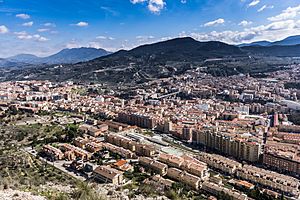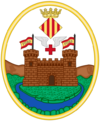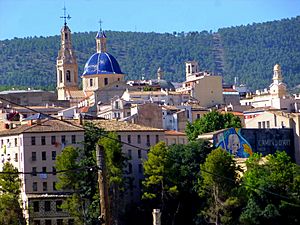Alcoy, Spain facts for kids
Quick facts for kids
Alcoy
|
|||
|---|---|---|---|
| Alcoy / Alcoi (official) | |||

Panoramic view of Alcoy, Alicante Province
|
|||
|
|||
| Country | |||
| Autonomous community | |||
| Province | Alicante | ||
| Comarca | Alcoià | ||
| Judicial district | Alcoy | ||
| Area | |||
| • Total | 129.86 km2 (50.14 sq mi) | ||
| Elevation | 562 m (1,844 ft) | ||
| Population
(2018)
|
|||
| • Total | 58,977 | ||
| • Density | 454.158/km2 (1,176.26/sq mi) | ||
| Demonyms | Alcoyan • alcoià, -ana (va) • alcoyano, -na (es) |
||
| Time zone | UTC+1 (CET) | ||
| • Summer (DST) | UTC+2 (CEST) | ||
| Postal code |
03801-03804 and 03818
|
||
| Official language(s) | Valencian and Spanish | ||
Alcoy (also called Alcoi) is a busy city in the Valencian Community, Spain. It's known for its industries and a university. The Serpis river flows through the city. In 2018, about 61,135 people lived here.
Contents
History of Alcoy
The first signs of people living in the Alcoy area are from about 60,000 years ago. These were Neanderthal hunters who settled at a place called El Salt. Later, around 10,000 to 6,500 years ago, people made rock paintings near La Sarga.
Around 2500 BC, people started moving from caves to the open plains. They began growing cereals and built strongholds in the mountains.
Roman and Medieval Times
After the Romans took over the Iberians' lands, they built farms and a burial ground in the area. The city of Alcoy was officially started in 1256 by King James I of Aragon. He built a castle in a good spot over the Serpis river. This castle helped protect the southern border of the Kingdom of Valencia during the Reconquista, which was when Christian kingdoms took back land from Muslim rule.
In 1291, King James II of Aragon gave the town to a Sicilian admiral named Roger of Lauria. Alcoy did not become royal property again until 1430.
Later History
During the War of Spanish Succession, Alcoy supported Archduke Charles. Because of this, the city was attacked and lost many special rights. This led to a difficult time for Alcoy.
In 1873, workers in Alcoy took part in a protest known as the Petroleum Revolution.
Main Sights to See
Alcoy has many interesting places to visit, including outdoor rock paintings. You can also see some old ruins from an Iberian settlement, with pieces of Greek and Roman pottery.
Many buildings in the city have special artistic or historical value:
- Casa del Pavo (Turkey's House): An Art Nouveau building designed by Vicente Pascual Pastor in 1909.
- Cercle Industrial: Another Art Nouveau work by Timoteo Briet Montaud, built between 1909 and 1911.
- Casa d'Escaló: An Art Nouveau building by Vicente Pascual Pastor, from 1906-1908.
- Casa Laporta: An Art Nouveau building by Timoteo Briet Montaud, built in 1904.
- Casa Vilaplana: An Art Nouveau design by Vicente Pascual Pastor, from 1906.
- Casa Briet: An Art Nouveau building by Timoteo Briet Montaud, built in 1910.
- Llotja de Sant Jordi: This building was designed by the famous architect Santiago Calatrava and built from 1992 to 1995.
- Pont de Sant Jordi (St. George's Bridge): This bridge is in the Art Deco style and is a very famous symbol of the city.
- Plaça de Dins (Inside Square): A beautiful neoclassical square in the center of Alcoy.
- Església arxiprestal de Santa Maria (Archpriestal Church of Santa Maria): A church built in the Valencian Baroque style.
- Hermitage of St. Anthony the Abbot: A religious building dating from the 14th to 18th centuries.
- Torre de Na Valora: A watchtower from the 13th century.
- Barxell Castle: A 13th-century castle, likely built by Muslims. It has a rectangular main tower and a courtyard with a rainwater tank.
- Alcoy Cemetery: This cemetery is known for its unique architecture and beautiful Valencian Art Nouveau sculptures. It's part of the European Cemeteries Route.
- Convent of Sant Agustí: Rebuilt in the 18th century, it has paintings from the 16th century.
Museums in Alcoy
Alcoy has several interesting museums:
- Museu Alcoià de la Festa: This museum is all about the Moors and Christians of Alcoy festival. Visitors can learn about all the details and feelings of this international celebration.
- Archaeological Museum Camil Visedo: This museum, started in 1945, displays ancient artifacts found in the area.
- Shelter of Cervantes: An air-raid bunker used during the Spanish Civil War in 1938.
- Firefighters Museum of Alcoy: A museum dedicated to the history of firefighting in Alcoy.
Natural Parks Nearby
Alcoy is close to two beautiful natural parks:
Alcoy's Economy
Alcoy is an important industrial city. It has many factories that make textiles, paper, food products, and metal goods. The city also produces a lot of matches. Today, Alcoy is a key center for finance, business, and culture in its region.
Celebrations and Festivals
Alcoy is famous for its lively celebrations:
- Moors and Christians of Alcoy: This is the most important festival, held in April. It celebrates the historical battles between Moors and Christians.
- Cavalcade of Magi: Alcoy hosts the oldest parade of the Three Wise Men in the world.
- Jesuset del Miracle: This event is celebrated on the last day of January.
Sports in Alcoy
Alcoy has a well-known football (soccer) team called CD Alcoyano. They are famous in Spain for a saying: "tener más moral que el Alcoyano" (meaning "to have greater morale than Alcoyano"). This phrase is used for someone who never gives up, even when things look bad. The team plays in the Segunda División B at El Collao Stadium.
The city also has a roller hockey club, PAS Alcoy. They play in the OK Liga, which is the top roller hockey league in Spain.
Notable Residents
Some famous people from Alcoy include:
- Camilo Sesto (1946-2019), a popular singer.
- Vicente Pascual Pastor (1865–1941), a well-known architect.
- Carmen Jordá (born 1988), a racing driver.
See also
 In Spanish: Alcoy para niños
In Spanish: Alcoy para niños





